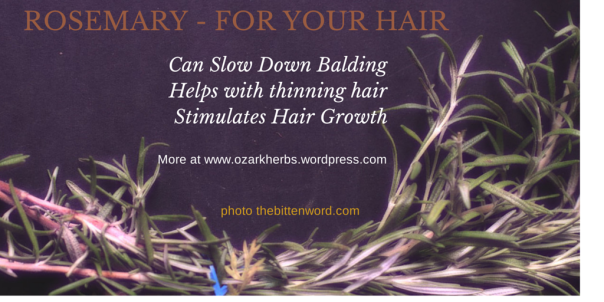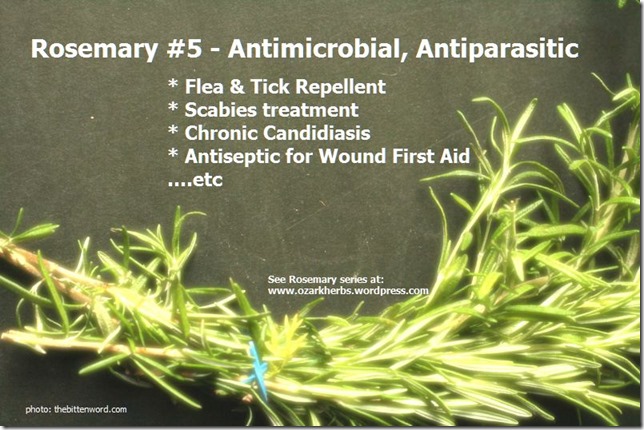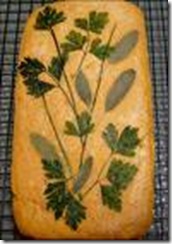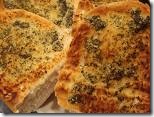Blog Archives
Rosemary #6 – Anti-Cancer
One of the really cool things Rosemary does is to block oestrogen, which promotes certain kinds of breast cancer. Research done at the State University of New Jersey demonstrated that a 2% concentration of Rosemary extract was able to inactivate excess oestrogen. How? Possibly by stimulating the liver enzymes responsible for inactivating the oestrogen hormones, oestrone and oestradiol.
We’ve already discussed how it can protect cells from radiation, obviously another way it can prevent cancer. But it does more to protect our DNA, through its antioxidant compounds: vitamin E (its a rich source), monoterpenes, phenolic diterpenes and flavonoids.
Research done at the department of Mutagenesis and Carcinogenesis, Cancer Research Institute of Slovak Academy of Sciences, in the Slovak Republic proved that Rosemary was able to significantly protect DNA from free radical damage.
Furthermore, in a study looking for agents effective against cancer cell lines,two components of Rosemary, carnosic acid and rosmarinic acid, showed direct anti-proliferative actions resulting in recommendation by the authors to consider Rosemary as part of cancer treatment with predetermined doses to prevent toxicity.
And this, my friends, is the final quickie post on Rosemary. There’s still much more to this herb which I’ll be covering in a video. Meanwhile, check out the 70 some odd recipes I’ve added to our Ozark Herbal Academy Pinterest site on the culinary uses of this majestic herb.
Research Studies:
Inhibitory effects of rosemary extracts, carnosic acid and rosmarinic acid on the growth of various human cancer cell lines.
Slovak Science Study on DNA Protection
Research on Estrogen Metabolism
Rosemary #5 – Eliminates Tiny Pests
Are you finding it helpful to break the study of Rosemary down into chunks? We have more to go. Today, think of this plant as a spunky, warm, broad-acting antiviral, antibacterial, antifungal, antiparasitic. Here’s a memorable list of actions:
Flea and Tick Repellent
Used in powdered form, alone, or combined with other repellent powders or diatomaceous earth.
Antibacterial:
Its been tested against the following and found effective: Staphylcoccus aureus , S. albus , Vibrio cholerae , Escherichia coli , and Corynebacteria, Remember that as a rule of thumb, direct antibacterial actions of herbs only apply to putting them in direct contact with the bacteria. So, for example, an external manifestation of staph would respond to topical Rosemary applications. The essential oil is recommended but you could also make a strong wash or compress using an infusion.
Rosemary oil has been found very effective in preventing the spoilage of meat due to gram negative and gram positive bacteria, I suppose this would make rosemary a good choice for marinades.
Antifungal
Candida albicans does not flourish in its presence, nor does Aspergillus parasiticus. Rosemary is one of the herbs used for chronic Candidacis.
Scabies
Rosemary essential oil is a traditional remedy for scabies.
Dr. Linda White and Steven Foster state that rosemary is a useful remedy for many types of parasites, and washing the infested parts of the body with rosemary tea may stop a scabies infestation.
Head Lice
We get mixed reports here. According to tradition, it works but a clinical trial evaluated it as a failure when it comes to head lice. As usual, finding specifics about what quality and formulation of rosemary was used in the study is missing.
First Aid for Wounds
To prevent infection, application of Rosemary as an essential oil or infusion (wash or compress) is a good choice for first aid. Remember that the essential oil ought to be diluted in a carrier oil. Virgin coconut oil is my first choice because its antimicrobial all by itself. Or, you could dilute it in fresh aloe vera gel…another good antiseptic wound healer. Wounds that are slow to heal benefit from a salve made with the oil or fresh leaf infused lard (never use salves on fresh wounds!)
Rosemary #4 – Digestive Aid
Rosemary is added to our cuisine for more than gustatory pleasure. It can actually improve our digestion of starches and vegetables, relieve an upset stomach and halt flatulence. Rosemary’s constituents, caffeic acid and rosmarinic acid act as antioxidants and anti-inflammatories which will go to work in the digestive system right away.
If you consider the energetics of Rosemary, as a warming, stimulating herb, you’ll easily associate it with the type of digestive issues its most suited to: cold digestive issues. These generally manifest as a lack of appetite, bloating, gas, and constipation.
I especially like it combined with Oregon Grape Root for the liver issues, and is additionally helpful in a pattern that often includes excessive, dilute urination from kidney deficiency and low blood pressure as well as inability to digest protein/fat efficiently.
A More Efficient Liver with Rosemary
Anything that can reduce the strain on the liver in its efforts to clear the body of toxins is an important ally, especially when a liver becomes sluggish. Researchers at National Institute of Agronomic Research in Dijon, France, discovered that Rosemary actually boosts the activity of detoxifying enzymes like cytochrome P450, glutathione transferase and quinone reductase , speeding up the elimination of toxins from the liver.
Kiva Rose writes,
I especially like it combined with Oregon Grape Root for the liver issues, and is additionally helpful in a pattern that often includes excessive, dilute urination from kidney deficiency and low blood pressure as well as inability to digest protein/fat efficiently.
Rosemary also helps by stimulating the flow of bile.
Back to energetics. Peter Holmes enlists Rosemary for the following energetically defined conditions:
Intestines (spleen) damp cold: indigestion, cold limbs, gurgling abdomen, loose mucousy stools
CHRONIC GASTROENTERITIS; colitis
Liver cold; right flank soreness, alternating constipation and diarrhea, frontal headache, chills
JAUNDICE, CHOLECYSTITIS, liver cirrhosis, gallstones due to damp or cold
Rosemary #3 – Powerful Protection from Radiation
Do you use a cell phone? WiFi? Have you been exposed to ionizing radiation? A new study shows that the risk for glioma (brain cancer) was tripled among those using a wireless phone for more than 25 years and that the risk was also greater for those who had started using mobile or cordless phones before age 20 years.These exposures also carry a high risk of other cancers and cardiovascular disease. Thankfully, along with other precautions, Rosemary can help us.
From “Rosemary Found to Offer Best Protection against Radiation Poisoning” by Barbara Minton we read:
RF/microwave exposure leads to cancer development
It has been know for a decade that RF/microwaves from cell phones and tower transmitters cause damage in human blood cells that results in nuclei splintering off into micronuclei fragments. The development of micronuclei heralds the development of pre-cancerous conditions. Many victims of Chernobyl developed blood cell micronuclei that rapidly turned into full blown cancers.
Numerous animal studies have demonstrated that mobile phone radiation quickly causes DNA single and double strand breaks at levels well below the current federal “safe” standards. A six-year industry study showed that human blood exposure to cell phone radiation had a 300 percent increase in genetic damage in the form of micronuclei, suggesting a health threat much greater than smoking or asbestos.….non-ionizing communications radiation in the RF/microwave spectrum has the same effect on human health as ionizing gamma wave radiation from nuclear reactions.
Its hard to believe that our familiar Rosemary is an effective natural agent to protect ourselves from radiation, but science says its true so let’s look at some of the studies.
Ionizing radiation generates massive free-radical production which damages cellular DNA. Four constituents found in Rosemary; carnosol, carnosic, rosmarinic and caffeic acids, ward off damage from radiation poisoning.
One study explored several compounds for their ability to protect cells from gamma-irradiation. As reported in the British Journal of Radiology, February 2, 2009 the fat soluble carnosol and carnosic acids in rosemary “provide highly significant protective anti-mutagenic activity”. It turns out that powerful water soluble antioxidants can’t match rosemary’s antioxidant activity against radiation damage. Even so, another study shows that water extracts of Rosemary were able to prevent skin damage from UV exposure.
Plants that grow in full sun develop strategies to protect themselves from excessive radiation. Rosemary is a good example of such a plant, whose sun protective compounds extend to those who consume it.Take, for example, it’s Rosmarinic acid. It acts as a photo-protector to the skin by scavenging free radicals and inducing the body’s own endogenous defense mechanisms. For example, malonyldialdehyde, one of the toxic compounds formed after exposure to UV radiation, it’s formation was inhibited by Rosmarinic acid. Rosmarinic acid was 3.34 times more effective in this action than any other compound tested. While taking Rosemary orally was found effective in protecting the skin from UV damage, it seems to me Rosemary essential oil would be ideal to add to your homemade sunscreen. Try blending coconut oil with a few drops of Rosemary EO.
Another constituent of Rosemary, Caffeic acid, was found to protect human lymphocytes from intense gamma radiation, finding that when lymphocytes were pre-treated with caffeic acid they were positively modulated against all radiation induced changes. Journal of Biochemical and Molecular Toxicology, 2008.
This animal study determined that Rosemary extract was a good radio-protector against lethal doses of gamma radiation. Animals were pre-treated with various doses of Rosemary extract prior to exposure and the dosage of 1000mg/kg of body weight turned out to be the most effective. This is more than I’d want to be taking on a regular basis but if I knew we were about to be exposed to high levels of gamma, I’d aim for this dose short term as a pre-treatment.
How much to take?
The German Commission E monograph on Rosemary suggests 3/4 to 1 1/4 teaspoons (4-6 grams) a day. An infusion can be made by adding 2 teaspoons (10 grams) to 1 cup (250 ml) of boiling water (removed from the heat) and steeped, covered, for at least 15 minutes. Strain and sip several times a day.
Its standard to use the tincture at 2-5 ml (1/2 – 1 tsp) three times a day, HOWEVER, high doses of Rosemary can damage the kidney so I recommend using the smaller dose of tincture, 1-5 drops.
Rosemary essential oil can be added to skin lotions, oils or creams to use directly on the skin at a 2% dilution.
Cautions:
While culinary use is safe, medicinal doses of this herb are not recommended for those suffering from heat conditions. If you experience sharp headaches, flushing, increased pulse, roaring in the ears …this herb is not for you. Back off of it, or try using it externally as the essential oil.
Never use this herb in high medicinal doses, greater that the above recommendations, because it can cause digestive upset, kidney damage and even convulsions.
Do not use medicinal doses during pregnancy, it can act as an abortifacient.
Ozark Herbal Academy offers a course on Radiation Protection that covers all of the risk factors and what to do to protect yourself, including the use of rosemary herb.
Rosemary Series #2 – Your Hair
 The tradition of using Rosemary as a hair rinse or Rubbing rosemary oil into the scalp originated in the Mediterranean long ago. But does it work?
The tradition of using Rosemary as a hair rinse or Rubbing rosemary oil into the scalp originated in the Mediterranean long ago. But does it work?
It does according to Valerie Ann Worwood, in her book, “The Complete Book of Essential Oils and Aromatherapy,” She recommends adding Rosemary essential oil to shampoo, conditioner, or a hair rinse. She claims that Rosemary’s oils help to stimulate cell division, dilate blood vessels and thus, stimulate hair follicles to grow hair.
A woman who fretted over her thinning hair attended my Rosemary dinner workshop where she learned how to use it for a scalp condition and hair growth. A couple of months later I saw her at another dinner workshop and she showed me new growth and a cleared scalp.
If you’ve been using Rosemary for you hair and seen results please let us know in the comments area. Here’s where you can find out more about how to prepare it for your hair.
The Rosemary Series – #1 Memory
Do you have trouble remembering everything you read about an herb? There’s so much to learn about Rosemary. I was just about to write a long article on it when I stumbled across a brilliant suggestion – serve up little bite-sized nuggets instead. So much easier to write, and to remember!
So we’re going to try this out. I’ll post regular short memory nuggets about Rosemary. If you follow along you’ll probably learn a lot more than by eating the whole meal at once. Just try to digest one nugget at a time! I’ll also add a photo that can easily be shared containing the main points. Please let me know if you like this idea and share your own thoughts and experiences to round it out a bit more.
Long known as an aid to memory, researchers have started conducting clinical trials to find out if its true. The short answer is, yes, it’s true. Not only does it aid memory but is considered a potential therapeutic agent to prevent and treat dementia. It helps with focus and improves both short and long term memory while lifting the spirit (an added flavor).
One randomized, placebo-controlled, double-blinded, repeated-measures crossover study titled, Short-term study on the effects of rosemary on cognitive function in an elderly population , with men over age 75 doses of dried Rosemary leaf that approximated what would be taken as part of the diet at near normal levels (750 mg) improved speed of memory but high doses impaired memory! So the take home is, if you skip a day of using the herb in cuisine, a cup of Rosemary tea or standard doses of tincture would keep the old brain cells lively.
An animal study sheds some light on the biochemistry behind Rosemary’s effects and concludes;
Rosemary, as part of a diet and medication can be a valuable proposal for the prevention and treatment of dementia…
The study suggests that RE [Rosemary Extract] led to improved long-term memory in rats, which can be partially explained by its inhibition of AChE activity in rat brain.
So we’ve seen positive results with Rosemary leaf and the extract, what about the essential oil?
This study compared Lavender and Rosemary essential oils. Both oils produced objective effects on mood and cognition. While Lavender improved mood, it flunked in the tests for improving working memory and it impaired reaction times for both memory and attention based tasks. Rosemary, on the other hand, “produced a significant enhancement of performance for overall quality of memory and secondary memory factors.” In this study speed of memory for the Rosemary group wasn’t as good as for the controls. If you want to experiment with this make yourself a Rosemary Memory Stick. Put some rock salt in a very small bottle that’s comfortable to hold up to your nose. Add about 20 drops of therapeutic grade Rosemary essential oil to it. Shake it. When you need a mental boost, inhale the aroma from this special bottle for about 3 minutes. Let us know how it works for you!
Rosemary,Basil and Thyme at the Blue Mountain – a comparison
I recently saw a statistic that said, in the United States, only 16% of the population lived in rural areas! The sparsely populated mountainous region of Newton County, Arkansas, is said to be the poorest county in the state. We don’t even have one traffic light here! Forget cell phone reception. And our county seat, Jasper, only has a population of about 500. So it was a big deal when a bakery, the Blue Mountain Bakery & Deli, opened it’s doors earlier this year. Folks in Newton County have a taste for the “real”, a taste for the sustainable, a taste for self-provision…and the Blue Mountain caters to that taste.
Naturally, I recognized it right away as the ideal spot to launch herbal dinner workshops. We started our monthly dinners in September with Jenny (co-owner of the Blue Mountain) preparing a special menu around the herb of the month. Dishes like Scallop & New Potato Thyme soup, Pumpkin-Thyme scones, Basil Lemon cookies, Rosemary marinated veggie –feta cheese kabobs….Over the two hour dinner we learn how these kitchen herbs can heal us.
The folks who’ve attended all three workshops soon came to realize how similar rosemary, basil and thyme are. They have in common the ability to ward off and treat colds and flu; lift moods; aid digestion; harmonize the liver; restore the nervous system; disinfect the urinary tract; ward off insects; anti-cancer…etc. They seem almost interchangeable, and they are, but they also have some unique characteristics setting them apart.
For example:
Skin care: Rosemary as a skin wash opens capillaries to enliven the skin and it’s used for eczema. Thyme, however, if used on the skin would be for antiseptic purposes and to treat psoriasis. Basil is especially good to relieve itchiness of the skin, especially if juiced and mixed with raw honey.
Alcohol : Thyme is used in a protocol to treat alcoholism. Basil is used to treat a hangover. No special application for Rosemary in this holiday arena.
Mental: A study found that basil’s phytochemicals act on the brain in the very same fashion as pharmaceutical anti-depressants (but without dependency or negative side-effects). Rosemary acts as an anti-depressant in a different manner and while it lifts the mood, its better known as a memory enhancer…it also has a special gift for protecting the cell membranes of brain, heart and kidney from damage. Both basil and thyme are used for coma. Thyme is the herb of choice for nightmares in children. Thyme may also be the better herb for insomnia, though basil may be close.
Digestive System: Basil helps digest protein; Rosemary helps digest starch; Thyme helps digest fats. All are anti-parasitic but Thyme stands out for eliminating tapeworm and hookworm. All assist the liver but in different ways. In the case of diarrhea, use thyme.
Muscles: All three are powerfully antispasmodic however thyme’s specialty is to strengthen weak muscles in MS and in children who aren’t developing normally. (Thyme was known as the herb of “courage and strength”). Basil takes the prize as the superior antispasmodic.
This is just a brief comparison, if you’re interested in learning more keep an eye out for my webinar series. Yes, I’m moving some of this work into a virtual classroom…the only thing holding me back is learning the technology (and possibly my computer!!) but its on the horizon.
Wishing you all an especially joyous holiday season with a plentitude of rosemary, basil and thyme.
Dia de Los Muertos – Remember The Rosemary!
Rituals celebrating the death of ancestors by indigenous peoples in America go back about 3,000 years. Yesterday Sunhawk gave me an introduction to her ancestors at the altar with its ofrendas that she’d set up over the weekend. Photos of departed family, friends, even pets are displayed among marigolds and candles. She explained that during the month of October the spiritual realm is vibrationally closer to us so we’re better able to communicate with those who’ve passed. Every day, until the actual Dia de Los Muertos on November 2 (although the day can vary in different areas), there’s talk about and to, the departed.
Sunhawk, Silverwolf and I toasted our visitors with wine (after Sunhawk filled their tiny cups on the shrine) and shared a meal of pasta and stories about various individuals and the tradition itself.
I thought to myself, what a coincidence that this is my Rosemary month! I’m giving a Rosemary Dinner Workshop in collaboration with the Blue Mountain Bakery & Deli in Jasper, Arkansas this week. You see, for many hundreds of years, Rosemary has been known as the herb of remembrance! And it, too, has an ancient association with the dead as well as sacred ritual. In the past, rosemary was placed in coffins, on coffins, and given to mourners to wear. Part of the reason, in some cases, was that rosemary disinfects and protects against contagion. In churches, when there wasn’t any frankincense or myrrh to burn for incense, rosemary was considered the next best thing.
Now I doubt Rosemary has yet joined marigolds (thought to attract the dead to the offerings left for them) or the traditional pan de muerto as a necessary inclusion. But, if recent scientific research showing how it improves our minds and hearts can persuade traditionalists to adopt it…rosemary has a place on the table at the very least…burned as incense, too.
Consider this;
- As a central nervous system stimulant, Rosemary essential oil increases the generation of Beta waves in the brain (wakefulness)
- Research confirms that its an anti-depressant and lowers anxiety (See here and here)
- Studies reveal several ways Rosemary protects the brain, aiding memory:
- Rosemary extract shows significant ability to enhance NGF (nerve growth factor) needed for growth and functional maintenance of the nervous system (See here )
- The carnosic acid in Rosemary has a protective effect against oxidative stress on cortical neurons (See here)
- Rosemary is one of the best substances to protect the brain (& all cells in the body) from radiation. (See here and here )
- It’s carnosic acid may safeguard dopaminergic neuronal cells from environmental neurotoxins (See here)
- Rosemary, especially when combined with curcumin, shows ability to ward off Alzheimers. (Source)
Herb Breads for Winter Warmth
As I write I’ve a small pan of orange peel and caraway seed simmering on the woodstove in brown sugar. Mixed in with flour and yeast it will grow into a sweet caraway “quick bread”…leaving a lingering fragrance to clear stuffy winter air. The “breads of winter” are nurturing medicine, especially when herbs are added.
Did you know that some herbs and spices actually encourage the activity of yeast? Try ginger, caraway, cardamom, cloves, mace, nutmeg, or thyme to give your dough an extra lift. Small amounts of cinnamon help too, just limit it to no more than 1/4 teaspoon to a cup of flour (more than that inhibits the yeast). As tempting as it may be to experiment with adding dry mustard – don’t. Its a yeast killer.
Though fenugreek and rosemary don’t enhance yeast growth, they will act as a preservative. If you toss a sprig of rosemary on your baking sheet it will scent the loaf and the air. Remember, the scent of rosemary is supposed to be a memory-stimulant. Traditionally, rosemary was burned by the beds of sick patients,in some hospitals it was combined with juniper berries to purify the air and prevent infection. Yet another reason to fill the kitchen with that delicious rosemary.
And don’t forget decorating the top of the loaf with seeds. Either gently push into the bread before baking or brush the top with egg white/water and sprinkle. In addition to sesame and poppy seed, start collecting the seed from your catnip plants,clean them and use as you would poppy seeds. They give a subtle minty flavor. Very nice on a lemon bread. Experiment with licorice flavored anise or fennel seeds, celery seeds (great on bread sticks used for dips). Its fine to mix the seeds into the dough, either whole or ground.
An interesting seed to add to your bread is Milk Thistle (Silybum marianum). Russian scientists studied adding it to breads to learn how it might affect the metabolism. Well, it turns out that Milk Thistle bread exerted a general restorative influence, increasing internal protection resources, capacity for work and vital activity. ( Gil’miiarov et al. 1998). I’ve no idea how much was used, perhaps calculating doses by the slice? Also, I would crush or grind the seed first.
Here’s another tip–for hop’s growers–put some of those hops aside for your baking. Grind your cones into a powder and infuse it. When it cools enough, add your bread yeast to it. You won’t have to knead as long to get an exquisite texture into your bread.
Remember to make up some herbal butters for your breads and top breads with garlic, basil, rosemary, oregano and parmesan as seen to the right.
Add some sage to your bread dough and scones. If you use thyme, go easy, its very strong.
Fresh herbs are best but in baking, dried herbs are just fine; use 1/3 to 1/2 of the fresh herb measurement.
Since I’m talking “food medicine” I really ought to point out that wheat is another fabulous medicinal food. Just be sure its whole grain and NOT gmo. The book 101 Foods that Could Save Your Life, by David Grotto tells us the following about whole grains:
Longevity: Eating whole grains is associated with longevity and lower risk of many different types of disease in women.
Heart Health: Several studies show reduction in cholesterol and triglycerides when whole grains, as opposed to refined grains, are part of the diet.
Rheumatoid Arthritis: A study of rheumatoid arthritis patients who were given a fermented wheat germ extract in addition to their steroid therapies found significant improvement compared to steroid use alone.
Cancer: A meta-analysis revealed that there is an inverse relationship between whole grain consumption and colorectal, gastric,and endometrial cancers.
Diabetes: People who consume at least three servings a day of whole grain foods are less likely to develop type 2 diabetes than those who consume less. In a study of nearly 3,000 middle-aged adults, whole grain consumption was associated with lower levels of total and LDL cholesterol, and improved insulin sensitivity. Fasting insulin was ten percent lower when whole grains were consumed versus when refined grains were eaten.
Obesity: According to a study in the American Journal of Clinical Nutrition, people who consumed the most whole grain foods had a lower body mass index (BMI).
To get the most out of your grains, soak them before using them. The reason being that all grains contain phytates which interfere with absorption of calcium, magnesium, copper, iron and especially zinc. Traditionally folks knew to soak their grains overnight. According to the Weston Price Foundation, soaking grains in warm acidulated water for as little as seven hours will neutralize most of the phytates. What this means for “medicinal herbal bread making” is that we use sour dough or the overnight sponge method. If you grind your own grain, an even better approach is to soak it whole, dry it and grind it. If it starts to sprout a little it gives a pleasant malty flavor that delights yeasts. Whole grains are also a lot easier to grind if you’ll soak, dry, then grind.
Eating a lot of unfermented grains, due to these phytates, is connected to bone loss and mineral deficiencies. An occasional “quickie” bread of regular flour is ok, but do make an effort towards slow food whole grain fermentation before baking or eating.
Now then, would like the recipe for the sweet caraway bread?
Sweet Caraway Batter Bread
Prep Time: 45 minutes
Cook Time: 45 minutes
Ingredients:
1 cup water
2 tbsp brown sugar
1 tbsp butter
1 tbsp grated orange peel
1 tsp caraway seeds
.1/4 cup milk
2-1/4 tsp active dry yeast
1 tsp salt
2-2/3 cups bread flour
Preparation:
In small saucepan, boil the water, brown sugar, butter, orange peel, and caraway seeds for 3 minutes. Remove from heat and let cool until lukewarm.
Pour boiled liquids in bowl. Mix in milk, yeast, and salt. Stir until yeast is dissolved.
Mix in flour.
Cover bowl with clean kitchen towel or plastic wrap and let rise in warm place for 30 minutes.
Stir down batter.
Scrape batter into a greased bread pan, 9x5x3 inches. Cover and let rise in warm place for another 30 minutes or until double in size.
Bake at 375 degrees for 45 minutes or until bread sounds hollow when tapped on.
Remove loaf from pan and let cool.












